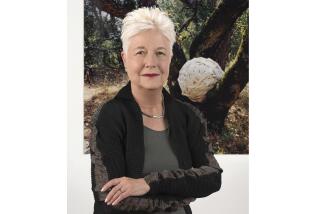Colleen Moore, Film Star of Flapper Age, Dies at 87
Colleen Moore, the effervescent film star of the Roaring â20s, whose bobbed hair became synonymous with the frenetic Flapper of that storied era, died Monday morning at her ranch home in Templeton, Calif.
The most popular film actress of 1927 and 1928 was 87 and had lived in Templeton, south of Paso Robles, for many years.
A self-admitted movie addict from the time she was a child (she said she practiced crying and other dramatics while walking to school in Tampa, Fla.), she broke into films not through arduous years of study and sacrifice but because of a simple debt.
Her uncle, Walter Howey, the tyrannical Chicago city editor immortalized by Ben Hecht and Charles MacArthur in âThe Front Page,â had helped D.W. Griffith get âThe Birth of a Nationâ and âIntoleranceâ past the censors.
Repaying the Debt
When the prodigious director asked how he might repay that debt, Miss Moore recalled in her 1968 autobiography, âSilent Star,â Howey told him about his film-struck niece, Kathleen Morrison.
But her uncle realized that her given name wouldnât fit a theater marquee, âso after a half-dozen beers and a longing to do something for the Irish, they made up the name Colleen Moore.â
If the myth of hard work reaping its own reward wasnât true in her case, the show business tale of quick recognition was.
She made her first film, âBad Boy,â when she was only 16. In a few brief years she became the first star to earn $10,000 a week ($12,500 at her peak.) She snipped off her curls in what F. Scott Fitzgerald was later to dub âthe most fateful haircut since Samsonâsâ and cut a wide swath during one of the most flamboyant periods in American history.
(It was Fitzgerald who also wrote that he was the âspark that lit up Flaming Youthâ and that âColleen Moore was the torch.â)
The executives and the men who ran the studios were not much older than the stars they partied with: Irving Thalberg was 28 and shortly would be the power behind Louis B. Mayerâs throne at Metro-Goldwyn-Mayer; Bud Schulberg of Paramount was 33, Bernie Fineman, who would head RKO, was 30 and John McCormick, Western representative of First National Studios, was 29. He became the first of her four husbands.
America was preoccupied by such youth. And actresses who photographed much beyond the age of 16 often found themselves returning to their hometowns via bus. Enter Billy Bitzer, a Griffith cameraman who had taken a piece of fine net used normally for veils and placed it over the camera lens.
The first beneficiary was a 22-year-old Griffith star named Lillian Gish and the process transformed her into a believable 12-year-old, thus prolonging by years the careers of the rosebud-lipped ingenues of the silent screen.
âNow they could make middle-aged ladies look like glamorous young sirens,â she told The Times in a 1967 interview. . . . âEvery actress took heart.â
None more so than Miss Moore herself, who was to play the eternal girl longer than any.
Banned in Boston
She was 23 when McCormick ordered her hair cut for the film âFlaming Youth.â The sight of the girl with the short boyish hair and figure to match was too much for the censors in Boston, who banned the film. It proved a publicistâs nirvana.
In reaction, women across the country abandoned their curls and their curves, ushering in the age of the Flapper, now seen as an early ripple in the wave that has become feminism.
In more than 50 films, until shortly before her retirement in 1934, she was the most flaming Flapper of them all, kicking up her heels before the cameras by day and by night in the Hollywood clubs where studio publicists sent their stars to shine after dark.
Her luck lasted in one more significant area: When films began to talk after 1928, producers found Miss Moore could too. Where many silent stars were forced into retirement, many of her more interesting pictures lay ahead, including the 1934 âThe Power and the Gloryâ with Spencer Tracy, which she considered her favorite.
Her other best-known pictures include âElla Cinders,â âSo Big,â âSallyâ and âLilac Timeâ for which she chose a young unknown named Gary Cooper as her leading man.
She and McCormick divorced in 1930 and after a brief marriage to Albert P. Scott, a stock broker, she wed another investor, Homer Hargrave, in 1936. It was Hargrave--later a vice president of Merrill Lynch, Pierce, Fenner & Smith--who took the Flapper out of films and into a second career--his.
Wrote Book on Market
She learned stocks and bonds so well that she wrote a book, âHow Women Can Make Money in the Stock Market,â boasting quietly that she was one woman who really had.
She also became known for a $450,000 fairyland doll house that she constructed and moved around the country as a fund-raiser for various charities. One of its miniature chandeliers is said to have included stones from one of her diamond necklaces.
Hargrave died in 1964 but not before she adopted his two children who in turn gave her six grandchildren and two great-grandchildren.
She traveled and married for a fourth time, in 1982 to Paul Maginot, a construction industry executive who survives her.
And if she ever looked back at her film career, it was not with regret. âThe public wanted me to go on being the young kid I had been. Now who could do that? So I went out and discovered America and found my family.â
A funeral service will be held at St. James Episcopal Church in Paso Robles at 3 p.m. Wednesday.
More to Read
Only good movies
Get the Indie Focus newsletter, Mark Olsen's weekly guide to the world of cinema.
You may occasionally receive promotional content from the Los Angeles Times.










